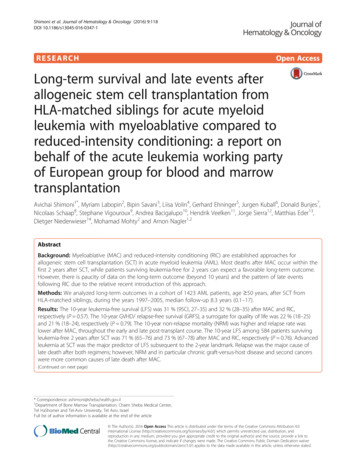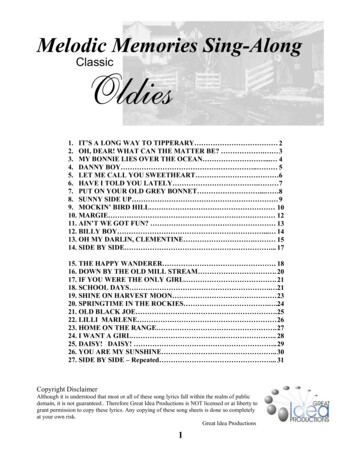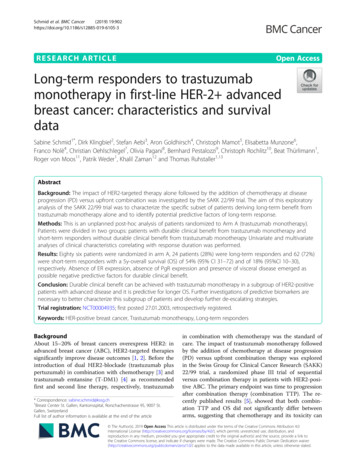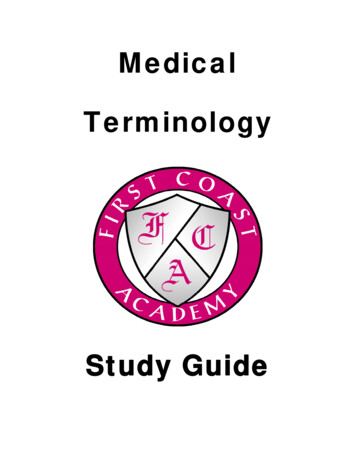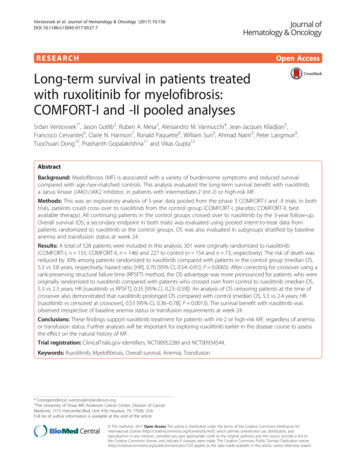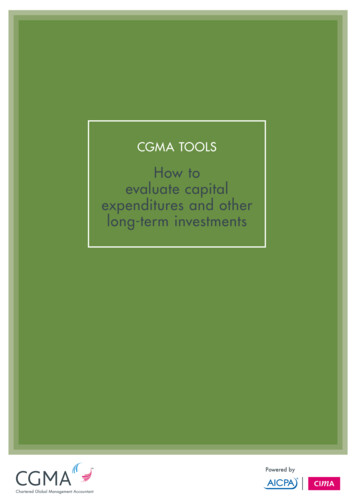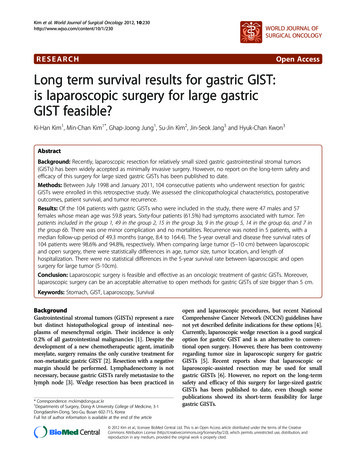
Transcription
Kim et al. World Journal of Surgical Oncology 2012, 10:230http://www.wjso.com/content/10/1/230WORLD JOURNAL OFSURGICAL ONCOLOGYRESEARCHOpen AccessLong term survival results for gastric GIST:is laparoscopic surgery for large gastricGIST feasible?Ki-Han Kim1, Min-Chan Kim1*, Ghap-Joong Jung1, Su-Jin Kim2, Jin-Seok Jang3 and Hyuk-Chan Kwon3AbstractBackground: Recently, laparoscopic resection for relatively small sized gastric gastrointestinal stromal tumors(GISTs) has been widely accepted as minimally invasive surgery. However, no report on the long-term safety andefficacy of this surgery for large sized gastric GISTs has been published to date.Methods: Between July 1998 and January 2011, 104 consecutive patients who underwent resection for gastricGISTs were enrolled in this retrospective study. We assessed the clinicopathological characteristics, postoperativeoutcomes, patient survival, and tumor recurrence.Results: Of the 104 patients with gastric GISTs who were included in the study, there were 47 males and 57females whose mean age was 59.8 years. Sixty-four patients (61.5%) had symptoms associated with tumor. Tenpatients included in the group 1, 49 in the group 2, 15 in the group 3a, 9 in the group 5, 14 in the group 6a, and 7 inthe group 6b. There was one minor complication and no mortalities. Recurrence was noted in 5 patients, with amedian follow-up period of 49.3 months (range, 8.4 to 164.4). The 5-year overall and disease free survival rates of104 patients were 98.6% and 94.8%, respectively. When comparing large tumor (5–10 cm) between laparoscopicand open surgery, there were statistically differences in age, tumor size, tumor location, and length ofhospitalization. There were no statistical differences in the 5-year survival rate between laparoscopic and opensurgery for large tumor (5-10cm).Conclusion: Laparoscopic surgery is feasible and effective as an oncologic treatment of gastric GISTs. Moreover,laparoscopic surgery can be an acceptable alternative to open methods for gastric GISTs of size bigger than 5 cm.Keywords: Stomach, GIST, Laparoscopy, SurvivalBackgroundGastrointestinal stromal tumors (GISTs) represent a rarebut distinct histopathological group of intestinal neoplasms of mesenchymal origin. Their incidence is only0.2% of all gastrointestinal malignancies [1]. Despite thedevelopment of a new chemotherapeutic agent, imatinibmesylate, surgery remains the only curative treatment fornon-metastatic gastric GIST [2]. Resection with a negativemargin should be performed. Lymphadenectomy is notnecessary, because gastric GISTs rarely metastasize to thelymph node [3]. Wedge resection has been practiced in* Correspondence: mckim@donga.ac.kr1Departments of Surgery, Dong-A University College of Medicine, 3-1Dongdaeshin-Dong, Seo-Gu, Busan 602-715, KoreaFull list of author information is available at the end of the articleopen and laparoscopic procedures, but recent NationalComprehensive Cancer Network (NCCN) guidelines havenot yet described definite indications for these options [4].Currently, laparoscopic wedge resection is a good surgicaloption for gastric GIST and is an alternative to conventional open surgery. However, there has been controversyregarding tumor size in laparoscopic surgery for gastricGISTs [5]. Recent reports show that laparoscopic orlaparoscopic-assisted resection may be used for smallgastric GISTs [6]. However, no report on the long-termsafety and efficacy of this surgery for large-sized gastricGISTs has been published to date, even though somepublications showed its short-term feasibility for largegastric GISTs. 2012 Kim et al.; licensee BioMed Central Ltd. This is an Open Access article distributed under the terms of the CreativeCommons Attribution License (http://creativecommons.org/licenses/by/2.0), which permits unrestricted use, distribution, andreproduction in any medium, provided the original work is properly cited.
Kim et al. World Journal of Surgical Oncology 2012, 10:230http://www.wjso.com/content/10/1/230In this report, we present a retrospective review evaluating the clinicopathological characteristics, postoperative outcomes, patient survival, and tumor recurrence ofgastric GISTs after surgical treatment. Moreover, wetried to confirm the safety and efficacy of laparoscopicsurgery for gastric GISTs larger than 5 cm in size.MethodsPatients’ evaluation and work upWe reviewed the medical records of 104 patients withgastric GISTs who underwent curative resection inDong-A University College of Medicine between July1998 and January 2011. Patients with unresectablemetastasis or concurrent cancer other than gastric GISTwere excluded. We made the diagnosis of gastric GISTby final pathology among the patients with gastric submucosal tumors which were found preoperatively byesophagogastroduodenoscopy (EGDS), abdominal computed tomography (CT), and endoscopic ultrasonography (EUS).According to risk classification suggested by Miettinenet al., the gastric GISTs were divided into eight groupsbased on maximum tumor diameter and mitotic activityper 50 high-power fields (HPFs), as previously detailed(Table 1) [7]. Patient characteristics, measured perioperative parameters that included operation method and typeof resection, operative times, length of hospitalization,complication, tumor recurrence, median follow-up periods,and patient survival were evaluated. Also, we comparedthe clinicopathologic characteristics and postoperativeoutcomes of patients with large tumors (5 to 10 cm)between laparoscopic and open surgery.Table 1 Suggested guidelines for assessing the malignantpotential of gastric GISTs of different sizes and mitoticactivityBenignGroup 1 (no larger than 2 cm, no more than 5 mitoses/50 HPF)Probably benign (very low malignant potential)Group 2 ( 2 cm and 5 cm, no more than 5 mitoses/50 HPF)Group 3a ( 5cm and 10 cm, no more than 5 mitoses/50 HPF)Uncertain or low malignant potentialGroup 4 (no larger than 2 cm, 5 mitoses/50 HPF)Low to moderate malignant potentialGroup 3b ( 10 cm, no more than 5 mitoses/50 HPF)Group 5 ( 2 cm and 5 cm, 5 mitoses/50 HPF)High malignant potentialGroup 6a ( 5cm and 10 cm, 5 mitoses/50 HPF)Group 6b ( 10 cm, 5 mitoses/50 HPF)From [7].GIST gastrointestinal stromal tumor, HPF high power field.Page 2 of 8Follow up methods and treatmentOn very low- and low-risk groups according to a previous classification [8], CT was checked every 6 monthsduring first the 2-year period, and then every year duringnext 3-year period. Endoscopy was performed every yearfor the first 5 years. For the intermediate and high-riskgroups, CT was checked every 3 months for the first2 years and then every 6 months for the next 3 years.Endoscopy was performed every year for the first 5 years.In cases of resectable tumor recurrence, we performedadditional surgery. In the other cases of unresectabletumor recurrence, imatinib treatment was started at anoral dose of 400 mg daily and was increased to 600 to800 mg daily if the disease progressed.Laparoscopic surgical procedureAfter the induction of general anesthesia, the patientwas placed in the reverse Trendelenburg and supine position. The surgeon stood on the patient’s right, with thefirst assistant on the patient’s left and the camera operator on the surgeon’s right. Typically, an umbilical trocar(10 mm) was inserted using the open method. A carbondioxide pneumoperitoneum was created using the umbilical port, and the pressure was maintained between 12and 14 mmHg. A rigid (30 degree) laparoscope was thenintroduced through the umbilical port. Under laparoscopic guidance, an additional two (5-mm and 12-mm)trocars were introduced, consisting of the right subcostaland right mid-abdominal ports. Occasionally, we insertedan additional 5-mm trocar at the left mid-abdominal area(Figure 1).After the gastric wall had been devascularized andexposed using Harmonic ACE (Ethicon Endo-Surgery,Cincinnati, OH, USA), wedge resection of the gastricwall was performed using laparoscopic stapling devices(Echelon Flex, Ethicon Endo-Surgery, Cincinnati, OH,USA).Resected specimens were placed into an endoscopicretrieval bag and extracted via the umbilical wound. Inall cases, our pathologist reported a free margin of normal gastric wall on frozen section biopsy. One closedsuction drain was placed around the surgical site at theend of the procedure and trocar wounds were closed.Statistical analysisChi-square and independent t-tests were used to compare the clinicopathological factors of patients betweenthe laparoscopy and open surgery group using GraphPadInStatW (version 3.06, GraphPad Software, Inc., La Jolla,CA, USA). Statistical significance was assumed forP-values 0.05. Survival curves were calculated by theKaplan-Meier method. The log-rank test was used toanalyze survival differences and SPSS version 18.0 (SPSS,Chicago, Ill, USA) was used for the analysis.
Kim et al. World Journal of Surgical Oncology 2012, 10:230http://www.wjso.com/content/10/1/230Page 3 of 8Patient characteristicsFigure 1 The locations, size and site of the trocar. Routinely,three ports (5-mm, 11-mm, and 12-mm) were used duringlaparoscopic surgery. Occasionally, if a further site was needed, a5mm trocar was introduced into the left mid-abdominal area.Table 2 shows a summary of clinical features of the104 patients who underwent laparoscopic and open surgery for gastric GISTs. There were 47 male and 57 femalepatients, with a mean age of 59.8 SD 10.5 years. Fortypatients (38.5%) were diagnosed incidentally and wereasymptomatic. Among 64 (61.5%) symptomatic patients,the most common symptom was pain. Sixty-one (58.7%),24 (23.1%), and 19 (18.2%) of the 104 tumors werelocated in the upper portion, middle portion, and lowerportion of the stomach, respectively. The patients weresubdivided into eight groups according to Miettinen’sclassification: 10 (9.6%) in group 1, 49 (47.1%) in group 2,15 (14.4%) in group 3a, 9 (8.7%) in the group 5, 14 (13.5%)in group 6a, and 7 (6.7%) in group 6b. Laparoscopic andwedge operation were more frequently performed. Surgical margins were all observed to be free on histopathologic studies. There was no tumor rupture duringsurgery. Among 104 patients, there was one minor complication in a laparoscopic wedge resection. One patientwho experienced delayed gastric emptying was treatedwith conservative care. Recurrences were noted in fivepatients during a median follow-up period of 49.3 (range8.4 to 164.4) months.Yearly operative trends for gastric GISTsClinicopathologic characteristics and postoperativeoutcomes of laparoscopic and open surgery for larger 5to 10 cm tumorsFigure 2 shows the operative methods (laparoscopic andopen) of the patients who underwent curative resectionsin our institute during the period between 1998 and2010. The numbers of laparoscopic cases has increasedannually.To evaluate differences between laparoscopic and opensurgery for larger tumor (5 to 10 cm), we compared thetwo groups. There were statistically significant differences in age, tumor size, tumor location, and duration ofhospital stay (Table 3).ResultsFigure 2 Yearly operative trends for primary gastric gastrointestinal stromal tumor (GIST). The numbers of laparoscopic resections hasincreased annually since 2007.
Kim et al. World Journal of Surgical Oncology 2012, 10:230http://www.wjso.com/content/10/1/230Page 4 of 8Table 2 Characteristics and surgical outcomes of 104patients with gastric gastrointestinal stromal tumor(GIST)Table 2 Characteristics and surgical outcomes of 104patients with gastric gastrointestinal stromal tumor(GIST) (Continued)Characteristic or outcomeRecurrenceAge, years*Value59.8 10.5GenderMale/female, n (%)47 (45.2)/57 (54.8)Body mass index, Kg/m2*24.1 3.1Yes/noMedian follow-up period, months, mean(range)5 (4.8)/99 (95.2)49.3 (8.4, 164.4)*Values are mean and standard deviation; †based on the Miettinenclassification; n, number of patients.Symptom, n (%)Asymptomatic40 (38.5)Symptomatic64 (61.5)Pain37Dyspepsia12Bleeding8Palpable mass2Dizziness5Tumor locationUpper/Middle/Lower, n (%)*Tumor size, cm61 (58.7)/24 (23.0)/19 (18.3)5.1 3.3Prognostic group†, n (%)Group 110 (9.6)Group 249 (47.1)Group 3a15 (14.4)Group 3b0 (0)Group 40 (0)Group 59 (8.7)Group 6a14 (13.5)Group 6b7 (6.7)Operation, n (%)Laparoscopy/openTable 4 shows the clinicopathologic characteristics forrecurrent cases after curative resection. Tumors recurredin five patients. The recurrent cases belonged to group 5,6a, and 6b according to Miettinen’s classification. Initialoperations for these patients were open surgery in fourpatients and laparoscopic surgery in one patient. Tumorsrecurred in the peritoneum (two patients), the remnantsof the stomach (one patient), the liver (one patient) andthe colon (one patient). Three patients underwent reoperation, and two were treated only with imatinibmesylate. Among the patients with tumor recurrence,two have survived to date.SurvivalThe 5-year overall and disease-free survival rates of gastric GISTs were 98.6% and 94.8%, respectively (Figure 3).Comparison of cases of laparoscopic and open surgeryfor large tumors (5 to 10 cm) showed that there wereno statistically significant differences in 5-year overalland disease-free survival rates between the two groups(P 0.067 and 0.083, respectively) (Figure 4).80 (76.9)/24 (23.1)Type of resectionWedge resection90 (86.5)Partial gastrectomy9 (8.7)Total gastrectomy5 (4.8)Status of surgical margin, n (%)Positive/negative0 (0)/104 (100)Tumor rupture during operation, n (%)No/yes104 (100)/0 (0)*Operation times (minutes)Laparoscopy91.1 57.0Open165.8 75.6Length of hospitalization (days)*Laparoscopy4.6 2.3Open9.8 4.1Complication, n (%)Yes/noRecurrence after curative resection1 (1.0)/103 (99.0)DiscussionSurgical resection with negative margins without lymphadenectomy has been the treatment of choice of gastricGISTs up to now [1]. Histologically, a 1 to 2 cm marginhas been thought to be necessary for adequate resection[9,10]. However, more recently, DeMatteo et al. [11] saidthat tumor size and negative microscopic surgical margins did not determine the survival. It is thereforeaccepted that the surgical goal should be complete resection with gross negative margins only [3,11]. Given this,wedge resection has been advocated by many investigators for the majority of gastric GISTs [3,10,11]. Currently,gastric GISTs are viewed as a good indication for laparoscopic resection. Moreover, the development of laparoscopic stapling devices and surgical techniques has madelaparoscopic wedge resection an attractive alternative toconventional open surgery [12]. In this study, laparoscopic surgery has been performed with an annuallyincreasing tendency, and wedge resection was morecommonly advocated. This shows that laparoscopic wedge
Kim et al. World Journal of Surgical Oncology 2012, 10:230http://www.wjso.com/content/10/1/230Page 5 of 8Table 3 Clinicopathologic characteristics andpostoperative outcomes of laparoscopic and opensurgery for larger 5 to 10cm tumorsAge, years*Laparoscopy(n 24)Open (n 14)P-value57.4 8.165.9 12.20.014Gender, n0.309Male124Female121024.1 2.924.0 3.3No93Yes15116.1 1.37.2 Body mass index,Kg/m2*Symptom, n0.8560.472Tumor size, cm*Tumor location, n0.0350.041Type of resection, n0.067†Prognostic group , nGroup 20.239Group 3a51Group 4114Group 521Group 6a68Operative times,minutes*119.8 62.2154.3 53.50.092Hospital stay, days*4.8 1.89.2 3.2 0.001No2314Yes10Complication, n1.000Recurrence, n0.132No2311Yes1362.6 (8.9, 164.4)58.3 (18.8, 123.2)Median follow-upperiods, months (range)0.180*Values are mean and standard deviation; †based on the Miettinenclassification; n number of patients.resection has become the mainstay of treatment for gastricGIST.Recent reports from the National ComprehensiveCancer Network (NCCN) GIST Task Force and the GISTConsensus Conference under the auspices of The European Society for Medical Oncology (ESMO) state thatlaparoscopic or laparoscopic-assisted resection may beused for small gastric GISTs (that is, those 2 cm insize) [6]. However, Ronellenfitsch et al. [13] stated thatthe tumor size did not determine the feasibility of laparoscopic wedge resection, and the location of thegastric GISTs did not directly affect the indication forlaparoscopic wedge resection. Whereas Yang et al. [14]reported on the performance of laparoscopic wedgeresection for tumors less than 6 cm in diameter,Ronellenfitsch et al. [13] and Huguet et al. [15] reportedits feasibility for tumors bigger than 10 cm in diameter.The Japanese clinical practice guidelines for GIST suggestthat laparoscopic resection of gastric GISTs smaller than5 cm appears safe when performed by a skillful surgeonwho is thoroughly familiar with the neoplastic characteristics of gastric GISTs [16]. Before 2005, in our institutewe performed open surgery for tumors bigger than 5 cmand for those located at the cardia. As our experiencehas increased, we have been performing laparoscopicsurgery on tumors smaller than 10 cm regardless of theirlocation.We classified the 38 patients who had large tumors(5 to 10 cm) into those who received laparoscopic versusopen surgery. Although there were statistically significantdifferences in age, tumor size, and tumor location, wethought that these variables were not considered to befactors that were comparable between laparoscopic andopen surgery. From the point of view of the merit oflaparoscopic surgery, the length of hospitalization wasstatistically shorter in laparoscopic surgery than in opensurgery. Moreover, the operation time was shorter inlaparoscopic surgery, although there was no statisticaldifference. In terms of survival rates, there were no statistical differences in overall and disease-free survival rates,although the survival graphs appeared to be different.In the case of gastric GISTs bigger than 10 cm, surgeons were concerned about the operative methods oflaparoscopic versus open surgery. The merits of laparoscopic surgery included lesser degree of pain, smallerwound size, shorter hospital stay, and earlier recovery.However, in order to safely retrieve a mass bigger than10 cm, a larger wound incision was needed, as in opensurgery. Moreover, laparoscopic surgical techniquesbecame more difficult in cases with bigger gastric GISTs,and there was a possibility that tumor cells would spreaddue to the rupture of the capsules. Therefore, with biggertumors, special attention should be paid to the prevention of capsular rupture. It should also be emphasizedthat careful laparoscopic evaluation of the tumor size,and its characteristics in terms of the possibility of capsular rupture during further manipulations, should be performed, giving timely conversion to the open methodwhenever necessary. In our series, for the prevention oftumor spread during laparoscopic surgery, we tried tograsp the stomach and normal tissues around the tumor.
Kim et al. World Journal of Surgical Oncology 2012, 10:230http://www.wjso.com/content/10/1/230Page 6 of 8Table 4 Clinicopathologic characteristics of recurrent cases after curative resectionNSexAgeSize of primarytumor (cm)Prognosticgroup†Type of operationInterval ofoperation(months)Site of recurrenceTreatment ofrecurrenceSurvival1F655.0Group 52M379.0Group 6aOpen51.8PeritoneumGleevec, .0Group 6bOpen5.14F639.0Group nAlive5F817.6Group 6aOpen14.7PeritoneumGleevecDeadN patient number, F female, M male; †Based on the Miettinen classification.In our study, there were seven patients with tumorsbigger than 10 cm, three of whom underwent laparoscopic surgery, while four underwent open surgery. Inaddition, there were no capsular ruptures in the threepatients who had laparoscopic surgery.The recurrence rate after surgery in reported seriesranges from 17 to 24% [17,18]. In recurrent gastric GISTs,some reports demonstrated that a combination of surgery and targeted therapy may reduce the developmentof recurrence or decrease the risk of disease progression[19,20]. Although most of our patients who underwentsurgical resection were at very low, or low malignantpotential (74/104, 71.2%), we had a lower recurrencerate in our series compared to other reports [17,18].We experienced five cases (5/104, 4.8%) of recurrence,with a median follow-up time of 49.3 months (range,8.4 to 164.4 months) after surgical resection for gastricGISTs. Three patients underwent reoperation, and twowere treated with imatinib mesylate. Unfortunately, noneof the patients responded to imatinib mesylate, and twopatients who underwent surgical management are currently living.Although this was a retrospective research study oflaparoscopic and open surgery for gastric GIST, andlarge tumors 5 to 10 cm in size, and although it was nota case-matched study of laparoscopic and open surgery,it provides a basic guideline to determine the size-relatedindication for laparoscopic surgery for gastric GIST. Aprospective randomized controlled study of tumorslarger than 5 cm is necessary.ConclusionThe clinical outcomes of gastric GISTs with very lowor low malignant potential were excellent. The groupof patients who had gastric GIST with high malignantpotential showed an increased recurrence rate and lessFigure 3 Survival characteristics of all 104 patients. The 5-year overall survival rate (A) and disease-free survival rate (B) were 98.6% and94.8%, respectively.
Kim et al. World Journal of Surgical Oncology 2012, 10:230http://www.wjso.com/content/10/1/230Page 7 of 8Figure 4 Comparison of the 5-year overall and disease-free survival rate between laparoscopic and open surgery for larger 5 to 10cmtumors. The 5-year overall survival rates (A) and disease-free survival rates (B) were 100% and 92.9% (P 0.067) and 95.0% and 66.3% (P 0.083),in the laparoscopic and open surgery groups respectively.favorable survival rates, which merits careful attention.In terms of the operative method, laparoscopic surgerywas an effective oncological treatment for gastric GIST.Although this was a retrospective, research study in asingle institute, it is thought that laparoscopic surgerywould be a good alternative to open surgery for the treatment of large gastric GIST bigger than 5 cm in size.AbbreviationsEGDS: Esophagogastroduodenoscopy; EUS: Endoscopic ultrasonography;GIST: Gastrointestinal stromal tumor; HPF: High-power field; NCCN: NationalComprehensive Cancer Network; NIH: National Institutes of Health;ESMO: European Society for Medical Oncology.Competing interestsThe authors have no competing interests to declare.Authors’ contributionsKim KH, Kim MC carried out data collection. Kim SJ did pathological reexamination and diagnosis. Jung GJ, Jang JS, and Kwon HC helped draft themanuscript. All authors read and approved the final manuscript.AcknowledgmentsThis work was supported by the Dong-A University research fund. All authorsdisclose no financial relationships relevant to this publication.Author details1Departments of Surgery, Dong-A University College of Medicine, 3-1Dongdaeshin-Dong, Seo-Gu, Busan 602-715, Korea. 2Departments ofPathology, Dong-A University College of Medicine, Busan, Korea.3Departments of Internal medicine, Dong-A University College of Medicine,Busan, Korea.Received: 23 June 2012 Accepted: 26 September 2012Published: 31 October 2012References1. Nowain A, Bhakta H, Pais S, Kanel G, Verma S: Gastrointestinal stromaltumors: clinical profile, pathogenesis, treatment strategies andprognosis. J Gastroentrol Hepatol 2005, 20:818–824.2. Mochizuki Y, Kodera Y, Fujiwara M, Ito S, Yamamura Y, Sawaki A, Yamao K,Kato T: Laparoscopic wedge resection for gastrointestinal stromal tumorsof the stomach: initial experience. Surg Today 2006, 36:341–347.3. Heinrich MC, Corless CL: Gastric GI stromal tumors (GISTs): the role ofsurgery in the era of targeted therapy. J Surg Oncol 2005, 90:195–207.4. Demetri GD, Benjamin RS, Blanke CD, Blay JY, Casali P, Choi H, Corless CL,Debiec-Rychter M, DeMatteo RP, Ettinger DS, Fisher GA, Fletcher CD,Gronchi A, Hohenberger P, Hughes M, Joensuu H, Judson I, Le Cesne A,Maki RG, Morse M, Pappo AS, Pisters PW, Raut CP, Reichardt P, Tyler DS, Vanden Abbeele AD, von Mehren M, Wayne JD, Zalcberg J, NCCN Task Force:NCCN Task Force report: management of patients with gastrointestinalstromal tumor (GIST)–update of the NCCN clinical practice guidelines.J Natl Compr Canc Netw 2007, (Suppl 2):S1–S29.5. Otani Y, Furukawa T, Yoshida M, Saikawa Y, Wada N, Ueda M, Kubota T,Mukai M, Kameyama K, Sugino Y, Kumai K, Kitajima M: Operativeindications for relatively small (2-5cm) gastrointestinal stromal tumor ofthe stomach based on analysis of 60 operated cases. Surgery 2006,139:484–492.6. Blay JY, Bonvalot S, Casali P, Choi H, Debiec-Richter M, Dei Tos AP, Emile JF,Gronchi A, Hogendoorn PC, Joensuu H, Le Cesne A, Mac Clure J, Maurel J,Nupponen N, Ray-Coquard I, Reichardt P, Sciot R, Stroobants S, vanGlabbeke M, van Oosterom A, Demetri GD, GIST consensus meetingpanelists: Consensus meeting for the management of gastrointestinalstromal tumors. Report of the GIST Consensus Conference of 20–21March 2004, under the auspices of ESMO. Ann Oncol 2005, 16:566–578.7. Miettinen M, Sobin LH, Lasota J: Gastrointestinal stromal tumors of thestomach: a clinicopathologic, immunohistochemical, and moleculargenetic study of 1765 cases with long-term follow-up. Am J Surg Pathol2005, 29:52–68.8. Fletcher CD, Berman JJ, Corless C, Gorstein F, Lasota J, Longley BJ, MiettinenM, O’Leary TJ, Remotti H, Rubin BP, Shmookler B, Sobin LH, Weiss SW:Diagnosis of gastrointestinal stromal tumors: a consensus approach.Hum Pathol 2002, 33:459–465.
Kim et al. World Journal of Surgical Oncology 2012, 12.13.14.15.16.17.18.19.20.Page 8 of 8Matthews BD, Walsh RM, Kercher KW, Sing RF, Pratt BL, Answini GA,Heniford BT: Laproscopic vs open resection of gastric stromal tumors.Surg Endosc 2002, 16:803–807.Rosen MJ, Heniford BT: Endoluminal gastric surgery: the modern era ofminimally invasive surgery. Surg Clin North Am 2005, 85:989–1007.DeMatteo RP, Lewis JJ, Leung D: Two hundred gastrointestinal stromaltumors: recurrence patterns and prognostic factors for survival. Ann Surg2000, 231:51–58.Hyung WJ, Lim JS, Cheong JH, Kim J, Choi SH, Noh SH: Laparoscopicresection of a huge intraluminal gastric submucosal tumor located inthe anterior wall: eversion method. J Surg Oncol 2005, 89:95–98.Ronellenfitsch U, Staiger W, Kahler G, Strobel P, Schwarzbach M,Hohenberger P: Perioperative and oncological outcome of laparoscopicresection of gastrointestinal stromal tumour (GIST) of the stomach.Diagn Ther Endosc 2009, 2009:286138.Yang HK, Park DJ, Lee HJ, Kim HH, Kim WH, Lee KU: Clinicopathologiccharacteristics of gastrointestinal stromal tumor of the stomach.Hepatogastroenterology 2008, 55:1925–1930.Huguet KL, Rush RM Jr, Tessier DJ, Schlinkert RT, Hinder RA, Grinberg GG,Kendrick ML, Harold KL: Laparoscopic gastric gastrointestinal stromaltumor resection: the mayo clinic experience. Arch Surg 2008, 143:587–590.Nishida T, Hirota S, Yanagisawa A, Sugino Y, Minami M, Yamamura Y, OtaniY, Shimada Y, Takahashi F, Kubota T, GIST Guideline Subcommittee: Clinicalpractice guidelines for gastrointestinal stromal tumor (GIST) in Japan:English version. Int J Clin Oncol 2008, 13:416–430.Demetri GD, von Mehren M, Blanke CD, Van den Abbeele AD, Eisenberg B,Roberts PJ, Heinrich MC, Tuveson DA, Singer S, Janicek M, Fletcher JA,Silverman SG, Silberman SL, Capdeville R, Kiese B, Peng B, Dimitrijevic S,Druker BJ, Corless C, Fletcher CD, Joensuu H: Efficacy and safety ofimatinib mesylate in advanced gastrointestinal stromal tumors. N Engl JMed 2002, 347:472–480.Iesalnieks I, Rümmele P, Dietmaier W, Jantsch T, Zülke C, Schlitt HJ,Hofstädter F, Anthuber M: Factors associated with disease progression inpatients with gastrointestinal stromal tumors in the pre-imatinib era. AmJ Clin Pathol 2005, 124:740–748.van der Zwan SM, DeMatteo RP: Gastrointestinal stromal tumor: 5 yearslater. Cancer 2005, 104:1781–1788.An JY, Choi MG, Noh JH, Sohn TS, Kang WK, Park CK, Kim S: Gastric GIST: asingle institutional retrospective experience with surgical treatment forprimary disease. Eur J Surg Oncol 2007, 33:1030–1035.doi:10.1186/1477-7819-10-230Cite this article as: Kim et al.: Long term survival results for gastric GIST:is laparoscopic surgery for large gastric GIST feasible? World Journal ofSurgical Oncology 2012 10:230.Submit your next manuscript to BioMed Centraland take full advantage of: Convenient online submission Thorough peer review No space constraints or color figure charges Immediate publication on acceptance Inclusion in PubMed, CAS, Scopus and Google Scholar Research which is freely available for redistributionSubmit your manuscript atwww.biomedcentral.com/submit
RESEARCH Open Access Long term survival results for gastric GIST: is laparoscopic surgery for large gastric GIST feasible? Ki-Han Kim1, Min-Chan Kim1*, Ghap-Joong Jung1, Su-Jin Kim2, Jin-Seok Jang3 and Hyuk-Chan Kwon3 Abstract Background: Recently, laparoscopic resection for relat


